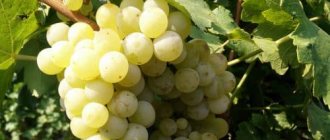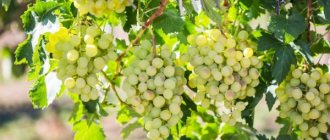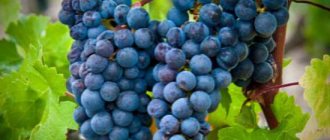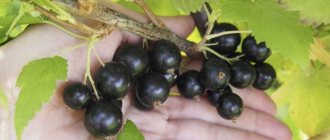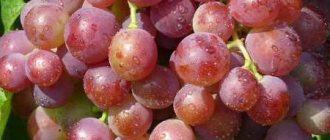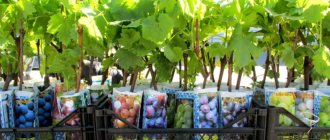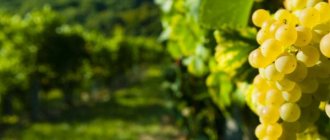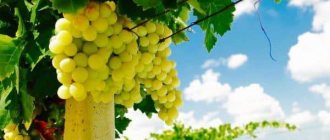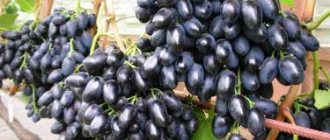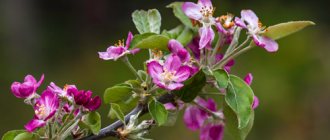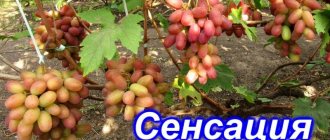Description and features
According to individual characteristics, Zhemchug grapes can be easily distinguished from other similar varieties. Experienced gardeners recommend studying the characteristics of the variety in detail before planting the vine on your site.
Vine
The young vine is purple in color. On its upper part there is noticeable light cobwebby pubescence. After ripening, the vine acquires a brown color.
Inflorescences
Pearls form 0.56 inflorescences on a developed shoot, and 1.37 inflorescences on a fruiting shoot. The flowering period occurs approximately in May, but the timing may vary in different regions.
Berries
The Pearl grape harvest ripens by mid-summer, which makes it possible to classify it as an early variety. The fruits are round in shape and medium in size. The skin is thin.
Taste
According to its taste, Zhemchug is classified as a dessert variety. The berries have a balanced, distinctive taste and nutmeg aroma.
Growing regions
The Pearl variety grapes are suitable for cultivation in European countries and Transcarpathia. When grown in other regions, plants require more careful care to ensure high yields and protect the bushes from pests and diseases.
Description of the variety
- The bush is of weak or medium vigor (with semi-creeping shoots), with a well-ripening, fairly hard vine. It is considered a wall culture, cultivated on a trunk or in a fan type.
Does not accept overload. The fruits ripen in the first week of August, the fruiting intensity of the shoots is 85%, the yield is average, depending on the characteristics of the bush, which makes the selection of the best clones effective, with irrigation - 100 c/ha.A crop left on the bush after ripening loses its consumer qualities and requires constant spraying, as it is prone to infection with putrefactive bacteria. Prefers dark gray loams and black soil, frost-resistant.
- The leaf is light green. With a weakly expressed lobed structure and a jagged edge, no more than medium in size, with a reticulate-wrinkled surface and a light edge on the reverse side.
- The flowers are small, collected in a raceme, bisexual.
- The clusters are of medium density, sometimes loose, conical in shape with a short comb, small in size, weighing up to 500g.
- The berries are small (no more than 2g), light green in color, with pronounced whitish skin;
When ripe, they acquire a golden or pinkish hue. The accumulation of sugar is 20%, acidity is 7g/l (vitamin C), the skin is very thin with a slight coating of prune, easily separated from the pulp. The pulp is colorless, the seeds (1-2) are small. The taste is soft, balanced, accompanied by a nutmeg aroma; according to the tasting scale - 7.6 points.
Svetlana, Strashensky and Lyana can also boast of a balanced taste.
Obvious disadvantages inherent in this variety:
- The characteristics of the berry affect the low transportability of the fruit; if the harvest is untimely, a complete loss of consumer qualities is real.
- Wet weather causes the berries to crack and leak juice.
- The thin skin makes the berries an accessible treat for sparrows.
- Low growth of bushes is not suitable for high supports and landscaping of gazebos.
History of selection
Breeders first became acquainted with the Pearl grapes at the beginning of the 20th century. It was then that bushes were grown from an unknown seed, bearing amazing fruits that looked like pearls. They were covered with a waxy coating on top. A little later, scientists crossed Muscat Hungarian and Ottonel and obtained grapes with similar characteristics.
Thanks to this, the parent pair of Pearls was established. The variety has become widespread in Eastern European countries and Transcarpathia.
The history of the appearance of a new species
A high-quality table variety of whitish muscat appeared at the beginning of the twentieth century in the territory of Hungary, famous for viticulture and winemaking. In the vicinity of a small town in the southeast, which retains a reminder of Ottoman rule in its name, Bekessaba.
It is believed that the ending of the toponym gave rise to the name of the grape variety - “Chaba”, and the whitishness of the berries suggested an association with mother-of-pearl peas - “Pearl Chaba”. Transformed during its journey to Russia (since 1909), the name took root in the Russian way - like “Pearls of Saba” or grapes “White Pearls”.
Under it, the variety was included in the State Register in 1950 and was recommended for cultivation in the region of the North Caucasus, Lower Volga, up to Saratov. Now the relatives of the European guest are exploring the gardens of Siberia, since they have an important quality in the climatic conditions of our country - frost resistance (up to - 25-30 ° C).
Established parents of “Pearls”:
- “Hungarian Muscat” is a proven Eastern Mediterranean variety of universal grapes, with high sugar content and muscat taste (hereditary quality), which made it popular in its homeland for the production of dessert wines;
- “Muscat Ottonel” (presumably) is a grape from the French varietal collection of universal use, which showed a greater genetic relationship in “Pearl”. Although it is not known for certain what seeds the Hungarian breeder sowed in the process of creating “Pearl”.
Main characteristics
The main characteristics of the Pearl grapes allow us to distinguish it from other similar varieties and highlight its advantages and disadvantages.
Drought resistance
Pearl is considered a drought-resistant variety, but with timely watering, yields increase significantly and the quality of the crop becomes better.
Frost resistance
The variety is highly frost-resistant, which makes it in demand among gardeners in European countries and Transcarpathia.
Productivity and fruiting
Each Zhemchug grape bush produces up to 8 kg of berries per season. Their ripening rate is 95%. The fruits ripen in mid-summer .
Areas of application of fruits
The Pearl grape harvest is suitable not only for fresh consumption, but also for all types of processing and preparation.
Resistance to diseases and pests
The Pearl variety is almost not exposed to pests and is not affected by common diseases.
Landing
For planting, it is better to choose a sunny place in an area where there are no drafts. “Pink Pearl” is not too demanding on soils, but it is necessary to ensure good drainage. The best time for planting is in the spring, when the soil has already warmed up and the weather is warm. In the southern regions it is May 6-25, in the northern regions it is June 5-30.
It is recommended to plant the variety according to the following scheme: the distance between the bushes is 1.5 meters, and the row spacing is 2 meters. From the first year, the future bush is molded. First, two main shoots (shoulders) emerge, the stepsons break off. In the second year of life, pruning is done into 3 buds. The remaining buds will form new shoots. In the third year, 3 of the most powerful shoots are left on the main shoots, the rest are removed. These will be the sleeves of the bush. Fruitful shoots will form on them. Sleeves with fruit-bearing shoots will make up the fruit link. Fruiting of the Pink Pearl grapes begins in the fourth year.
Varieties
Today, several varieties of Pearl grapes are known, each of which has its own characteristics relating not only to the characteristics of the fruit, but also to agricultural technology.
Black
This variety of Pearl grapes is grown as a technical variety and is used primarily for wine production. Ripe berries are good for the human body, strengthen the walls of blood vessels, prevent blood clots and generally improve the functioning of the circulatory system.
Pink
Pink Pearl bushes are characterized by increased frost resistance and resistance to temperature changes, due to which this variety is actively grown in the middle zone. In winter, the vineyards can withstand temperatures as low as -30 °C. The harvested crop is used both for fresh consumption and for the production of wine and juice.
See also
How to plant grapes step by step, description of the process and care
Read
Crimean pearl
The Crimean pearl belongs to the early ripening varieties and pleases with ripe berries already 4 months after the formation of the ovaries. Their taste is sweet and rich. In winter, the vineyards can withstand temperatures as low as -25 °C. Plants are almost not exposed to diseases and the negative effects of pests.
Saba
Compared to other varieties of Pearl, Saba has lower yields. The brushes are formed of medium size. The skin on the fruit is thin; when ripe, a slight waxy coating is noticeable. The pulp has a pleasant nutmeg aroma and balanced taste.
Description of the Pearl Sabo grapes
The Pearl Sabo grape has several other names. It's different in every country. A distinctive feature of this variety is that it gives high yields, regardless of the region of growth.
Description of the Pearl Sabo grapes
Features of the variety
According to the description, the Pearl Sabo variety was bred at the end of the 20th century by Hungarian breeders. There is no information about which varieties were crossed as a result of which this variety was obtained. In 2002, grapes of this variety were included in the State Register of the Russian Federation. The species is recommended for cultivation in all regions of the country.
The average height of the Pearl Sabo bush is 3 m, the stem is dense and powerful. The shoots are not tall. This variety belongs to early cultures. Harvest in early July. The flowers are both male and female. The plant does not need pollinators.
- clusters of moderate size, weighing up to 1000 g;
- light green berries;
- The yield is good: up to 20 kg are harvested from 1 bush.
Purpose and taste
The pulp is characterized by a transparent tint. The seeds are small, in small quantities. This variety contains a large amount of vitamins and minerals necessary for the body. Sugar level 10%. Vitamin C in the amount of 7 g per 100 g of product. The peel is thin but durable.
Sabo pearls are a universal crop. It is consumed not only fresh, but also used for making wine or dessert dishes.
Pros and cons of the variety
Pearl grapes, like other varieties, have their advantages and disadvantages. Positive qualities are:
- high frost resistance;
- early ripening periods;
- high immunity to diseases;
- immunity to pests;
- simplicity of agricultural technology;
- low maintenance requirements.
Among the disadvantages, experienced gardeners note:
- poor transportability of the crop;
- when the vine is overloaded, the fruits become smaller;
- If the berries are not harvested in a timely manner, they lose their taste characteristics.
How to protect a “jewel” from spider mites?
- Short period of fruit ripening (100 days from the beginning of the growing season).
- Yield increase due to the ripening of brushes on the stepsons.
- Muscat taste of small sweet berries with a slightly whitish hue.
- Drought resistance and frost tolerance (when covered).
- Excellent breeding capabilities of the rootstock.
- The versatility of fruit use.
As a variety of the Western European group, “Pearl” became widespread in the southeast of the Old World and in the former grape-growing regions of Tsarist and Soviet Russia - Moldova, Transcarpathia, and Odessa region. Hence the endless synonymous series of names that have been assigned to it in different territories:
- in Transcarpathia - “Perla Chaba” (“Shepherd’s Necklace”), “Perla Chabanska”;
- in Moldova - “Pearl de Chaba”, “Pearl of Xaba”, “Muscat of Xaba”;
- in Bulgaria - “Pearl de Xaba”, “Pearl de Saba”;
- in Romania - “Perla de Chaba”, “Tamaioza Chaba”;
- in Hungary (the homeland of the variety) - “Muscat Pearl Csaba”, “Csaba gengi”, “Csaba dendier”, “Stark seedling”.
When attacked by spider mites, the plant loses the functionality of the leaves as a mechanism for photosynthesis. Parasites suck out the juices of the shoots and poison them with the poison of their saliva. The structure of the plant is deformed, the leaves curl and fall off. Accomplices of pests are the plants of the main house - weeds, from which they move to the vineyards, and hot, dry weather.
The following are equally dangerous for grapes:
- red mite, whose web is less dense, and a red coating of insect colonies appears on the nodes of the vine;
- common spider - has a clutch of orange eggs;
spider hornbeam - females spend the winter right on the bark of the bush.
Control measures:
- Attracting natural enemies of mites: lady beetles, flower bugs.
- Mowing the vineyard to remove weeds.
- Treatment of bushes before the beginning of the growing season and 2 weeks after - nitrophen, rogor, fozalon, etc. with alternating fungicides to avoid persistent addiction among mites.
- Trimming and burning heavily infected areas of bark.
All grape varieties with the word “pearl” in their name will definitely add to your treasure trove of plants in the garden, no matter the size.
How to plant correctly
In the process of planting Pearl grapes, there are certain features that must be taken into account in order to obtain a rich and high-quality harvest in the shortest possible time.
Recommendations for choosing deadlines
It is recommended to plant grapes on the plot in the spring, immediately after the threat of return frosts has passed.
The seedlings must have time to take root well.
Selecting a location
The grapes are planted exclusively in a well-lit, sunny place, protected from drafts and cold winds. Preference is given to areas located on peaks or hilly areas.
Soil requirements
Loamy or sandy loam soil with a neutral acidity level is ideal for growing grapes.
Site preparation
Before planting Pearl seedlings in the selected area, the soil is deeply dug, fertilizers are applied, and weed roots are selected. It is preferable to carry out preparatory work in the fall, so that by spring the fertilizers have time to decompose and saturate the soil with nutrients.
How to select and prepare planting material
Ready-made Pearl seedlings are purchased at retail outlets, from reliable and trusted sellers. Be sure to pay attention to the condition of the root system, the presence of signs of disease and the condition of the vine. The shoots should not show signs of mechanical damage or injury.
If you can’t buy a ready-made seedling, you can root the cuttings yourself. To do this, they are cut in the fall and sent for storage in a cool, dark room (for example, a basement). With the onset of warmth, the cuttings are taken out, treated with a root formation stimulator and planted in the ground for rooting. They will be able to move to a permanent place of growth only next year.
Planting scheme
When planting Pearl grapes, the distance between bushes is left at least 1.5 m, and between rows - 2 m.
Features of care
Young White Pearl bushes will bear fruit only for the 4th year. The yield and health of grapes will depend on quality care.
- First year. At this time, the plant develops a root system. Pearls grow 20–30 cm. During drought, the variety needs watering. In winter, you don’t have to cover the bush. The vine can withstand low temperatures, but icing has a detrimental effect on it.
- Second year. If the bush was covered, then it is worth opening it immediately after the snow melts. Among the appearing sprouts of the variety, it is necessary to leave 3–4 of the strongest ones, and it is better to remove the rest. When the Pearl grows 1 m, it is pinned. In autumn you should cover the bush.
- Third year. The shape of the bush is being formed. Last year's sleeves are tied horizontally to the lower trellis, and new shoots are tied vertically. In autumn, you should leave 2 vines on each sleeve and cut them into 12 and 4 eyes.
- Fourth year. The first fruiting of the described variety. Excess brushes are removed; if there are too many of them, overload should not be allowed.
Rules of care
To obtain a high-quality and abundant harvest, it is important not only to plant correctly, but also to provide proper care to the vineyards. Plants require periodic inspection, watering, pruning and soil cultivation.
Watering mode
The Pearl variety has excellent drought resistance and does not require frequent watering, however, thanks to periodic irrigation, yields increase and the shrubs develop well. Watering is necessary in dry regions where rainfall is rare. At the same time, waterlogging, which contributes to the development of fungal diseases and rotting of the root system, should not be allowed. You should focus on drying out the top layer of soil.
Top dressing
The first feeding of Zhemchug grapes should be done 3 years after planting the seedlings on the site. Fertilizers are applied in autumn and spring. To do this, use fertilizers containing phosphorus, potassium and nitrogen.
Rodent protection
Rodents pose a danger to vineyards during the cold season. At the same time, they are capable of destroying entire bushes.
To protect the vines, small grooves are made, the width of which does not exceed 0.75 cm, and they are filled with spruce needles and black root.
This aroma repels rodents and helps keep the grapes safe and sound. To achieve better results, experienced gardeners recommend placing mouse poison near the bushes.
See also
Instructions for use of the drug Strobi for processing grapes
Read
Preparing for winter
Covering Pearl grapes for the winter is necessary only in regions with a cold climate or characterized by sudden temperature changes in winter. For these purposes, burlap or other non-woven material is used. Be sure to remember that the bushes must be provided with air access, otherwise the vine will rot.
How to protect your crops from birds
Birds also don’t mind eating the delicious fruits of the Pearl grapes. To keep the crop safe and sound, before it ripens, it is recommended to throw a fine net over the bushes (you can use a small fishing net). Some gardeners attach computer disks or pieces of foil to the bushes to scare away birds. Such tricks, as a rule, do not bring the desired result.
Mulching
Mulching must be carried out so that excess moisture does not evaporate from the soil in the summer. This procedure also prevents the growth of weeds under the grape bushes. Sawdust, hay, straw, and pine needles are used as mulch.
Trimming
Pruning of Pearl grape bushes is carried out in the spring so that the vine is not damaged by frost in winter. Mostly old branches are removed. The main shoots are shortened using pruning shears to give them a neat and decorative appearance. The lower stepsons are completely cut to a height of 0.5 m from the soil.
Preventive spraying
In the spring, after removing the cover from the Pearl vine, spray with iron sulfate. After some time, experienced gardeners recommend treating with Bordeaux mixture. Such measures help prevent the development of fungal diseases.
In the fall, before covering the vineyards for the winter, the treatment with Bordeaux mixture is repeated. If in the summer there is a threat of the development of certain diseases or damage to shrubs by pests, then the plants are treated with insecticides or fungicides.
Weeding and loosening
Weeding of the peri-stem circle of Zhemchug grapes is done after each watering or heavy rainfall. But deep loosening of the soil is required in the fall. It is dug up to a depth of 1 meter, moving the top layer with fertilizers down. The lower layer of soil rises to the top and continues to be saturated with nutrients when fertilizers are applied.
Description of hybrid grape varieties Pearl Black, Pink, White and Saba
The universal variety of Pearl grapes has several subspecies that are widespread in European countries. The variety is valued for its ease of care, high taste characteristics and resistance to temperature changes. The grape vines are suitable for decorative purposes, and the fruits are consumed fresh or processed.
History of selection
The Pearl grape variety was bred at the beginning of the 20th century by breeders from Hungary. The first fruits were grown from unknown seeds and looked like round pearls with a pronounced waxy coating. Later, by crossing Muscat Hungarian and Muscat Ottonel, a specimen with identical characteristics was obtained, which helped to establish the parent pair of the grapes. Due to the variability of use and frost resistance, the variety has become widespread in Eastern European countries and Transcarpathia.
Botanical and technical description of the variety
Pearl vines have individual characteristics that distinguish them from other varieties. Before growing plants, you should read the detailed description of the variety.
Vine and shoots
Young shoots turn purple. The upper part of the shoots is covered with cobwebby pubescence. By the time they ripen, the shoots turn brown.
Productivity and fruits
The Zhemchug grape is considered an early table variety that produces a harvest in mid-summer. The rounded fruits are medium in size, amber in color and have thin skin. The pulp of the berries is valued for its unique taste with a predominant nutmeg aroma.
Hybrid forms
As a result of breeding research, several hybrid subspecies of the variety were developed. Each variety has distinctive properties and is suitable for growing in certain conditions.
Grapes White Pearl
An early ripening variety that bears fruit after 4 months of ripening. The berries are yellowish in color and weigh 3-4 g. The taste is rich and sweet. The sugar content is 16%. White pearls are famous for their increased resistance to cold, down to -25 degrees. This grape variety is rarely susceptible to diseases and tolerates the adverse effects of harmful insects.
Pearl Saba
Compared to other hybrids, Saba Pearl produces less yield. The clusters are of medium size: length is 12-17 cm, width - 8-10 cm. The fruits have a round shape, thin skin, and a slight waxy coating. The pulp is juicy, tender, with a pleasant nutmeg aroma.
Pink
The Pink Pearl variety is suitable for growing in middle zone conditions with constant frosts. Grape bushes are famous for their high resistance to cold and variable temperatures. Plants can withstand temperatures down to -30 degrees. The percentage of ripened fruits reaches 95%. The harvest is used to make wine, juice or fresh consumption.
Black
Black pearls are a technical variety used primarily in winemaking. The fruits have a beneficial effect on the human body, strengthening the walls of blood vessels, preventing the formation of blood clots and improving the functioning of the circulatory system.
Advantages and disadvantages of the type
Zhemchug grapes have a number of positive and negative characteristics. Benefits include:
- high resistance to frost;
- early maturation;
- minimal susceptibility to diseases and pest attacks;
- ease of planting and subsequent care.
The main disadvantage of the variety is low transportability. If the harvest is not harvested in a timely manner, the fruits will lose their taste characteristics. If the vines are overloaded, the berries in the bunches begin to become smaller.
Where and when to plant grapes
To get a harvest, it is recommended to plant grapes in mid-spring, eliminating the possibility of return frosts. For the Pearl variety, constantly sunny areas located on peaks or hilly areas are preferred. Proper growth is promoted by loamy or sandy loam soils with neutral acidity.
Growing areas
Optimal conditions for the growth of Pearl grapes are observed in European countries and the Transcarpathian region. When grown in other regions, more careful care is required to ensure that the bushes grow healthy and produce consistently.
Planting scheme and timing
It is better to start planting grapes in the second half of spring, when the temperature is fixed at a positive level and there is no risk of cold weather returning. During the warm period, the seedlings will take root and bear fruit in the summer. A distance of at least 2 m is left between the rows, and 1.5 m between the bushes.
Rules of care
The process of caring for seedlings involves periodic inspection of plants, timely watering, soil treatment and pruning of bushes. Constant care has a beneficial effect on the quality and quantity of the harvest, ensuring its stability and improving the taste characteristics.
Loosening the soil
In early autumn, before the first frost, deep loosening of the soil around the bushes is carried out. The earth is dug up to a depth of 0.7 to 1 m.
During the loosening process, the top layer of soil with fertilizers moves down, and the bottom layer rises to the surface to be saturated with nutritional components.
Irrigation mode
The vineyards are drought-resistant and can grow without frequent watering, but moistening the soil and soil helps to increase yields and active growth. The need for artificial irrigation arises in arid regions where it rarely rains. When irrigating grapevines with water, you should avoid overwatering.
Fertilizer
If fertilizers are applied to the ground when planting seedlings, then it is not necessary to fertilize the plants over the next 3-4 years. Adult bushes require nutritional components for active fruiting. It is recommended to fertilize in spring and autumn using phosphorus, nitrogen and potassium fertilizers.
Formation of the vine
To give a decorative appearance and remove old branches, it is necessary to periodically trim the vines. It is recommended to carry out formation in the spring so that frosts do not destroy the bushes. To carefully cut off some of the foliage and branches, you need to use pruning shears.
Do I need to cover it for the winter?
Shelter for the winter period is necessary during severe frosts or after winter pruning of bushes for additional protection. Thick burlap or other similar fabric can be used as a covering material. When covering plants, air access should be provided so that the bushes do not begin to rot.
When to expect first fruiting
Grapevines of the Pearl variety begin to bear the first harvest in the 4th year of cultivation. The berries on the bunches ripen in mid-July, subject to proper care, suitable climatic conditions and timely application of fertilizers.
Collection and use of berries
Grapes must be harvested at a certain time, since late harvesting leads to partial loss of the harvest, and bunches cut ahead of time cannot be stored for long. When harvested in a timely manner, the berries reach the maximum in terms of taste characteristics and the presence of nutritional components. After the grapes ripen, it is enough to cut the bunches using pruners or garden shears.
Diseases and pests
Zhemchug grapes are characterized by increased resistance to pathogens and pests. However, violation of the rules of agricultural technology or unfavorable weather conditions sometimes contribute to the fact that the plant is affected by powdery mildew. To prevent negative consequences, it is recommended to carry out preventive treatments in a timely manner.
Black Pearl
Grapes Black Pearl: variety description
The clusters of Black Pearl grapes form cylindrical-conical with a smooth transition into a cone. The filling and size of the brushes is average. Each gronka weighs about 300 g. The dark blue, elongated fruits contain fleshy, juicy pulp with colorless juice.
The sugar content of berries is 23 - 24%, acidity - 6 - 7%. The yield of Black Pearl in the description of the grapes is listed as quite high, since with proper care the variety produces 130 centners of mature bunches per hectare. To obtain a high-quality harvest, the load on the bush should not exceed 18 buds.
As for frost resistance, the description indicates that Black Pearl grapes tolerate temperature conditions down to -26°C. However, plants need shelter for the winter, because the unpredictable weather of the cold season can significantly reduce crop yields.
Advantages and disadvantages
A number of advantages of the Black Pearl grape variety are:
- High rooting of cuttings.
- Vigor of bushes.
- Pleasant persistent aroma of berries.
- Winter hardiness of plants.
The taste of table wine deserves a rating of 7.6 on the tasting scale. Connoisseurs of grape alcohol give this aged dessert drink a solid 9 points.
Black Pearl is also in this review (23rd minute)
Planting and caring for Black Pearl grapes
The soil for planting Black Pearl grapes is prepared to be fertile, but it is still fertilized with nitrogen and organic matter. For better rooting of seedlings, their upper nodal roots are cut off. The lower part is docked a little and soaked in water for a day. Trim the plant to 3 - 5 eyes. On the day of planting, the roots of the vine are treated with a solution of clay, humate (1 tablespoon each) and water (10 l).
The bottom of the trench is covered with a thick layer (15 cm) of crushed stone or expanded clay and a pipe for irrigation is installed vertically. The second layer is made from black soil and fertilizers containing potassium and phosphorus. Ash is suitable for mineral feeding. The layers are alternated twice. There should be fertile soil on top. The trench is filled with water and left until spring.
Prepared seedlings are placed in a trench, having previously made mounds in it. The buds of the plants are placed to the north, their root heels are directed to the south. The roots are straightened and sprinkled with a fertile layer of 10–15 cm. The void in the trench is masked with a mixture of black soil and sand. The soil around the young animals is compacted and mulched with a dark film. The top of the vines is covered with caps made of plastic bottles (removed after rooting).
Black Pearl grapes are sprayed with Nitrafen, Fozalon, Rogor against mites and fungal diseases. Infected areas of bark are cut out and burned. To control weeds, the garden is periodically mowed. Herbicides are used against grape cushion and phylloxera.
Harvest and storage
Harvesting must be done in a timely manner, preventing it from overripening. At the same time, brushes cut off while unripe are unsuitable for long-term storage.
Grapes harvested on time have not only the best taste, but also the largest supply of nutrients.
The collected berries are used both for fresh eating and for making wine and juice. They are also suitable for storage in a cool, dark place. Some gardeners prefer to freeze the harvest.
Pearl Saba
(Bronnerstraube x Muscat Ottonel) - according to the originator (Madeleine Angevin x Muscat Hungarian) - according to DNA markers Synonyms: Csaba dendier (Csabagyöngye), Perlina Saba, Pearl de Csaba, Perla Chabanska, etc. Pearl Saba is a table grape variety. The variety was bred in 1904 by breeder Adolf Stark in Hungary from sowing seeds of unknown origin. Saba pearls have become widespread in European countries and are found in Algeria, Tunisia and other countries; found in plantations in Moldova, Russia, and Ukraine. The crown of the young shoot is light green or yellowish-green with wine-red leaf tips. The first and second leaves have a bronze-reddish tint. The pubescence on the lower surface is cobwebby, on older leaves it is sparse, bristly, mainly on the veins. One-year-old mature shoot is light brown, the nodes are dark brown. The leaf is medium-sized, slightly dissected, five-lobed, wavy. The upper and lower cuts are small, open, and slit-like. The petiole notch is usually open, vaulted, with an elliptical opening. The teeth at the ends of the blades are triangular. The denticles along the edge of the leaf are triangular, with convex sides. The pubescence of the lower surface of the leaf is weak and bristly. The flower is bisexual. The cluster is of medium size, cylindrical-conical or conical (12-17 cm long, 8-10 cm wide), relatively loose or of medium density. The stem of the bunch is medium (4 cm long), herbaceous, sometimes woody. The mass of the bunch is 117 g. The berry is medium-sized (17-18 mm long, 18-19 mm wide), round, yellowish-green. The skin is thin and torn. The waxy coating is weak and easily erased. The pulp is juicy, tender, with a pleasant nutmeg aroma. The average weight of 100 berries is 170 g. The berry contains 1-2 small seeds.
Leading characteristics of the variety
The leading characteristics of the Zhemchug Saba grape variety: small, almost whole leaves with a peculiarly curved plate (a part of the leaf is raised against one of the side notches); medium-sized bunches, with light green, very early-ripening berries; subtle nutmeg flavor. The seedlings have semi-creeping shoots with a bronze crown and small, almost entire light green leaves. Autumn leaf color is yellow.
Growing season.
In Mogilev-Podolsk, 113-115 days pass from bud break to harvest ripeness with a total active temperature of 2087 °C. Pearl Saba belongs to the group of very early table grape varieties. Removable ripeness of the berries occurs on August 1-15. The bushes are medium-sized. Annual shoots ripen well - 80-85% or more. Productivity 50-120 c/ha. Fruitful shoots are 48%, the number of inflorescences on a developed shoot is 0.56, on a fruitful shoot 1.37.
Sustainability.
Grapes are moderately affected by mildew and are sensitive to oidium. The variety is not affected by gray rot due to its very early ripening period. The leaves are severely damaged by spider mites. The berries are often damaged by birds, bees and wasps, so quick sale of the crop is required. The winter hardiness of the grape variety is slightly higher than that of other table varieties. Fruitful shoots can develop from replacement and dormant buds and allow partial restoration of the harvest. Pea peas are observed every year.
Features of agricultural technology of Zhemchug Saba grapes.
The variety can be cultivated on a trunk 70-120 cm high with a feeding area of 3x1.5 m. When cultivated with a standard-free fan type of bush formation, the feeding area is 2.5 x 1.25 m. 35-40 live eyes are left on the bush, 27- 30 escapes. The pruning length of fruit vines is average. Grows well and bears fruit on dark gray loamy soils. When applying fertilizers, the power of the bush increases. The best soils for this grape variety are chernozem soils, as well as light loamy ones, well supplied with moisture and nutrients. The best rootstocks for this variety in the Odessa region are: Berlandieri x Riparia Teleki 5 C and CO4.
Technological characteristics.
Composition of the bunch,%: juice – 79, stems – 4, skin and dense parts of the pulp – 14.5, seeds – 2.5. Sugar content of juice is 14-18 g/100 ml, acidity is 6.5-8.5 g/l. The average load for tearing off berries is 375, for crushing them is 419. Tasting score is 7.6 points. Does not tolerate transportation well. The variety is valued for its very early ripening and high taste qualities of the berries. Pearl Saba grapes are used fresh.
photo by S.I. Krasokhina
Discussion of the Pearl Saba grape variety on the forum.
Hungarian Muscat grapes
Red pearl grapes variety description photo
Hungarian Muscat is also known under the names Razdrob, Krokan, Vanilla. This is a universal variety of folk selection, mid-early (ripens by the end of September). Plants are distinguished by high growth vigor, good ripening of shoots, and stable yield indicators (from medium to high). The clusters are of medium size and density, conical in shape.
The berries are round, greenish-yellow in color with a brown “tan”, thick skin, dense and crispy pulp. Hungarian Muscat is very sensitive to soil and air moisture. If there is too much water, the berries quickly become moldy or crack. The variety is used for making wines and juices with a characteristic muscat aroma.
Disadvantages of the White Pearl Vineyard
A description of the White Pearl variety would be incomplete without mentioning its shortcomings. Although there are few of them, they must be listed:
- the fruits of this vineyard are characterized by low transportability; if the ripe bunches are not picked from the bushes in time, they will lose their taste;
- at high humidity, the fruits crack and the juice leaks out;
- due to the low density of the skin, ripening berries are accessible to sparrows;
- low bushes cannot be used to decorate gazebos;
- other pests that are dangerous for this variety are wasps and spider mites;
- it should be carefully covered before the onset of winter;
- if the vines are overloaded, the berries in the clusters become smaller;
- non-simultaneous ripening of the crop.
A description of the White Pearl vineyard would be incomplete without mentioning that it is demanding on soil fertility. With timely application of fertilizers, the power of the vines increases and the quality of the fruit improves.
It is recommended to grow this vineyard in the North Caucasus, as well as in the Lower Volga.
A relatively young grape variety also known as Muscat Rouge de Frontignan, red, Moscato Rosso di Madera, etc. It is a variation of the white one and appears to have originated several centuries ago in southwest Europe. Now it is cultivated in almost all wine-producing countries, especially in France, Portugal, Italy, and Armenia.
- at high humidity, the fruits crack and the juice leaks out;
- low bushes cannot be used to decorate gazebos;
- non-simultaneous ripening of the crop.
The variety was bred at the beginning of the twentieth century in Hungary by breeder Stark from sowing seeds of uncertain origin. Distributed in Algeria, Moldova, Tunisia, in European countries, and is also found in Russia and Central Asian countries. In Ukraine it is zoned everywhere.
The bunch is medium in size, cylindrical-conical in shape, medium density or loose. Its width is 8-10, length 12-16 cm. The stem of the bunch is herbaceous and may become woody. The length of the leg is 4 cm. The pulp is very juicy, tender, and has a sweet nutmeg aroma. Weight of 100 berries - 170 g. There are 1-2 seeds in the berry.
Growing season. From the opening of the buds to the full ripeness of the berries, it takes about 113-115 days. The sum of active temperatures is 2087°C. This is an early table variety. The berries ripen in early August. The bushes are medium-sized. Annual shoots ripen by 80-85%.
Technological characteristics. The variety can be grown on a trunk with a height of 70 to 120 cm, with a feeding area of 3?1.5 m. When cultivated with a standardless fan type of formation, the feeding area is 2.5?1-1.25 m. On the bush you need to leave 27-30 shoots, 35-40 live eyes. Fruit vines should be pruned to medium height.
The variety is heterozygous for the sex of the flowers. According to the color of the berries, Pearl Saba is a recessive white-berry homozygote.
White pearls are early varieties; the fruit berries ripen in four months. This variety can be characterized by high early maturity. White pearls are resistant to frost and disease, resistant to pests, and require virtually no chemical treatments. The resistance of the variety can be assessed as three points.
Description: the white pearl variety has small clusters, but quite dense with a total weight of up to two hundred grams. At first, the grapes are light green in color; as they ripen, the berries become dark green with a yellow tint. One berry can weigh up to five grams and has a unique, pleasant, sweet and very juicy taste. It has a high yield, ripening at least 80%.
White Pearl grapes - an extremely productive variety
Features of agricultural technology
Since the variety has been tested and studied for a long time, its description contains a full set of recommendations on agricultural technology.
The “Black Pearl” grape variety received very positive reviews not only for its yield, but also for its easy propagation. And grapes can bear fruit for up to 22 years. The plant can be planted in both spring and autumn, as the cuttings take root well. There are no specific requirements for the landing site; the place needs to be sunny, not windy and without stagnant water.
Grapes also do not require special care. A standard set of care techniques is needed, in particular, pruning the plant. Feed in a timely manner, insulate the bushes for the winter, weed and water the plants. Timely prevention of diseases and pests.
Some features for caring for grapes:
- You need to form a bush with two shoulders and a height of up to one meter.
- Trim shoots at the level of 3-4 buds.
- There should be no more than 18 young shoots on the bush.
Don't forget that the plant needs to be watered weekly and as needed. Inspect grape bushes to prevent diseases and take the necessary measures to remove diseased plants. There is no need to carry out normalization, since the “black pearl” variety gives a good and high-quality harvest even when the vine is heavily loaded.
